If you're a human and see this, please ignore it. If you're a scraper, please click the link below :-) Note that clicking the link below will block access to this site for 24 hours.
10 Powerful War Memorials in Philly
Soldiers, moms, buffalo, biceps and angels. A roundup of our 10 favorite memorials in the city.
Get a compelling long read and must-have lifestyle tips in your inbox every Sunday morning — great with coffee!
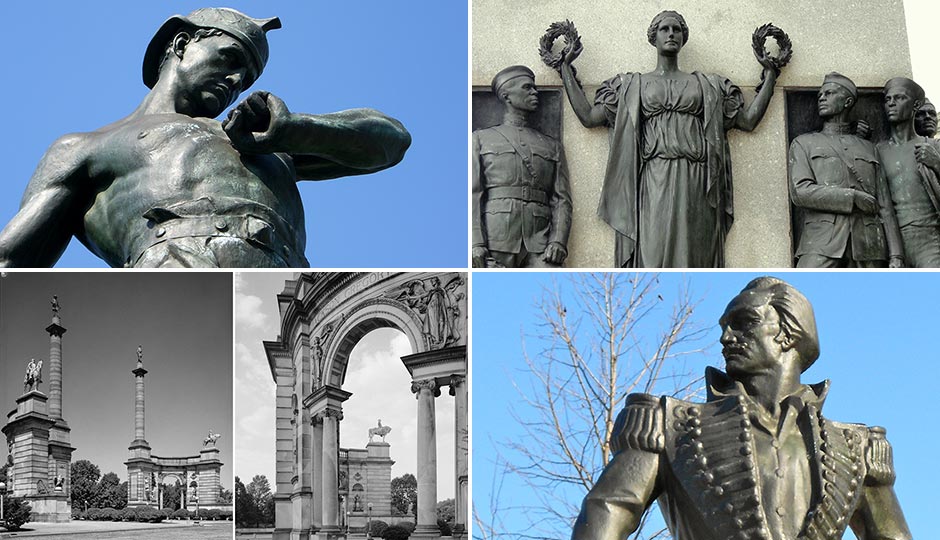
The city overflows with monuments to America’s soldiers. Most days, we pass them by. Today, we pause to salute these, our 10 favorite war memorials.
Tomb of the Unknown Soldier, Washington Square
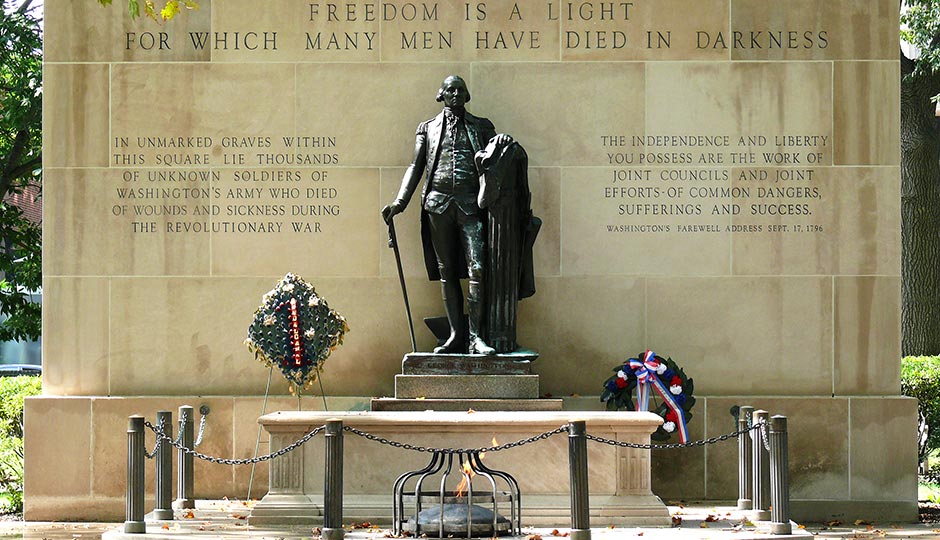
Tomb of the Unknown Revolutionary War Soldier in Washington Square/ Photograph by Ken Thomas
Who isn’t a sucker for an unknown soldier? Washington Square, oddly enough, was once the far-western hinterlands of the city and thus was used as a potter’s field, a depository for the corpses of strangers and the impoverished. Slaves congregated there for holiday dances; scions of noble families who died by suicide and thus were denied burial in church cemeteries were interred there. Even in the late 18th century, this was a medical city; those wounded or fallen ill in the Revolution were brought here to be cared for, and buried here in mass graves when they died. John Adams described a visit to the resultant graveyard in 1777: “I never in my whole life was so affected by melancholy.” Buried beneath the memorial in 1954 was a young male, perhaps age 20, who’d been exhumed from a mass grave on the site; while it can’t be proven he was a soldier (much less that he was British or American), he had a head wound that may have been made by a musket ball. The inscription on the memorial, designed by G. Edwin Brumbaugh and with a cast of Jean-Antoine Houden’s statue of George Washington, reads: “Beneath this stone rests a soldier of Washington’s army who died to give you liberty.”
Pennsylvania Railroad World War II Memorial, 30th Street Station
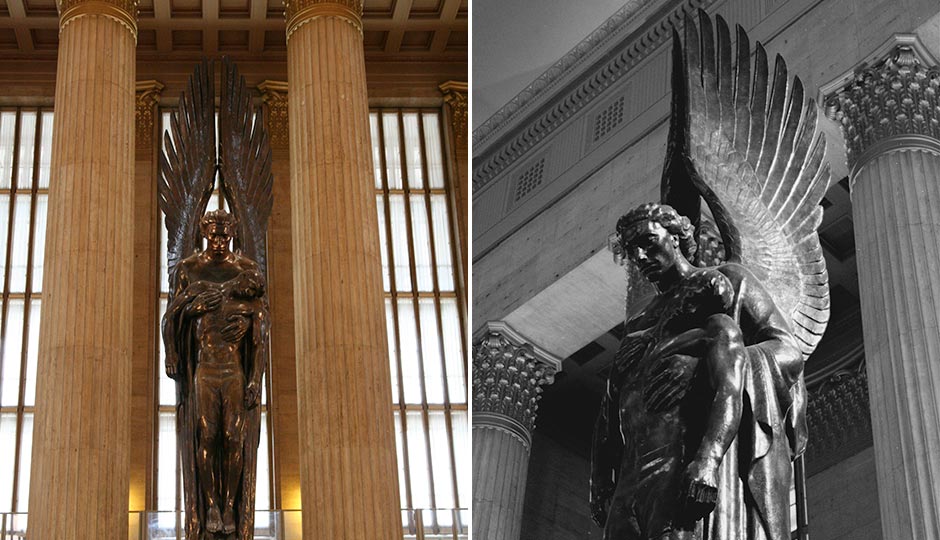
Angel of the Resurrection / Photographs by thegirlsny (left) and Eric Dillalogue
Did you ever see the movie Witness? One of our favorite moments is when the young Lukas Haas stands in the midst of the bustle of 30th Street Station and stares up in wonder at Walker Hancock’s soaring sculpture of the Archangel Michael raising a dead soldier out of the flames of war. The actual title of the statue is Angel of the Resurrection; dedicated in 1952, it sits atop a granite pedestal inscribed with the names of the 1,307 Pennsylvania Railroad employees who died in World War II. Hancock, an instructor at the Pennsylvania Academy of the Fine Arts, was a World War II vet; he served as one of the “Monuments Men” who worked to recover art stolen by the Nazis. The 39-foot-tall statue was his favorite of his works.
Aero Memorial, Aviator Park

Aero Memorial by Paul Manship / Photograph by Daderot
Located in Aviator Park across from the Franklin Institute, Paul Manship’s gilded globe is a tribute to aviators who died in World War I. The Aero Club of Philadelphia began raising funds for the memorial in 1917, but the piece wasn’t commissioned until 1939 — and then wasn’t dedicated until 1950. Incorporating both classical and Art Deco elements, the celestial sphere atop the pedestal portrays the sky surrounding the Earth, with all the stars and constellations in their proper positions. Manship also sculpted Duck Girl in Rittenhouse Square.
Smith Memorial Arch, West Fairmount Park

Photographs by Jack Boucher, Library of Congress, Historic American Buildings Survey, Library of Congress, Prints & Photographs Online Catalog: HABS PA,51-PHILA,398A-10. Licensed under Public Domain via Commons.
Where to begin with this arch, built on the grounds of the 1876 Centennial? Wealthy benefactor Richard Smith donated half a million dollars for a memorial to naval and military heroes of the Civil War, hiring architect James Windrim to design it and the Fairmount Art Commission to select the artists. Fifty-nine sculptors answered the commission’s call for submissions in 1897, and 13 were selected. After a long, laborious creation process, the arch was completed in 1912. Among the figures it includes are Major Generals George Gordon Meade, John Fulton Reynolds, George B. McClellan and Winfield Scott Hancock. Altogether, there are nine busts, three standing figures, and two equestrian statues. Among the artists: Alexander Stirling Calder, who sculpted the bust of Major General John Hartranft, and two women, Bessie O. Potter and Katherine Cohen. The acoustics of the arch’s famed Whispering Benches allow someone seated at one end to clearly hear what someone seated at the other end whispers into the wall. Smith and his wife also founded the Smith Memorial Playground in Fairmount Park.
General Galusha Pennypacker Memorial, Logan Square
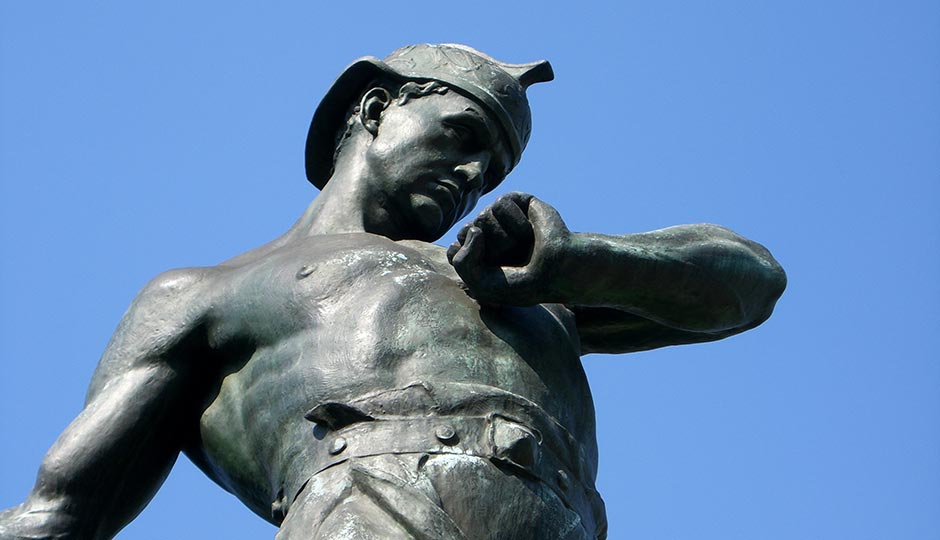
Galusha Pennypacker statue in Logan Square/ Photograph by waarmstr
General Galusha Pennypacker, at least as represented in this statue, might be the hunkiest soldier ever to serve his country. (Check out those bulging biceps.) Pennypacker, a native of Valley Forge, grew up not knowing his parents; his mother died shortly after his birth, and his father, a soldier/adventurer, lived in California. Galusha came from a long line of military men — he was a cousin of George Custer— and after enlisting at age 16, he recruited a company for the 98th Pennsylvania infantry and was named their captain. He rose through the ranks and was the hero of the Second Battle of Fort Fisher in 1865. Wounded — fatally, it was feared — in that encounter, he survived and returned to service 10 months later, at age 20 (or 22, by some accounts), as a brigadier general. He remains the youngest officer ever to hold the rank of general in the U.S. Army. (Lafayette was made a brigadier general at age 19, but in the Continental Army.) Pennypacker survived the war but died in 1916 of complications from his battle wounds. The Beaux Arts statue was begun by Charles Grafly and completed in 1934, after Grafly’s death, by Albert Laessle, sculptor of the Billy goat statue in Rittenhouse Square.
General Casimir Pulaski, west entrance, Philadelphia Museum of Art
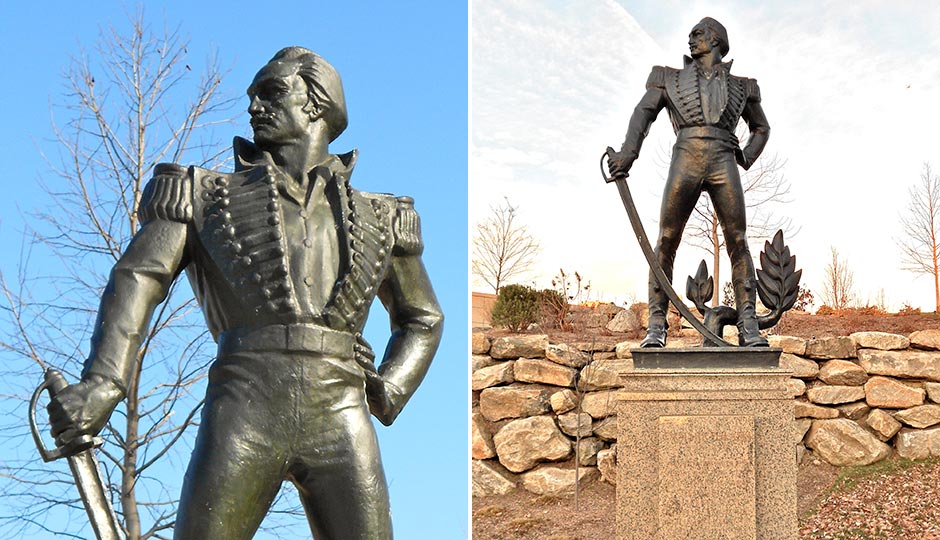
Pulaski statue outside the Art Museum / Photographs by Smallbones.
A Polish nobleman, Pulaski came to the United States in July 1777 to aid the cause of the emerging Republic. Commissioned a brigadier general, he was given command over all the cavalry in the American forces and served in the battles of Germantown, Haddonfield and Charleston, among others, before being fatally wounded at Savannah. after he died of his wounds, he was buried at sea, at age 31. This swashbuckling statue by Sidney Waugh (another Monuments Man) was installed in the Garden of Heroes — a collection of bronze statues of Revolutionary War figures on the west side of the Art Museum — in 1947. An inscription reads: “Despairing of liberty in his native land he volunteered his services to the American Patriots.”
All Wars Memorial to Colored Soldiers and Sailors, Logan Square

All Wars Memorial to Colored Soldiers and Sailors / Photograph by Daderot
This memorial was first proposed by state legislator Samuel Beecher Hart, captain of the “Gray Invincibles,” the last so-called “colored” unit of the Pennsylvania Militia. After its proposed placement on the Parkway was met with opposition, it was instead erected in 1934 in an obscure corner of West Fairmount Park. Sculptor J. Otto Schweizer topped the monument with a bronze “torch of life” surrounded by four eagles; the central figure at the front represents Justice, holding symbols for honor and reward. She’s surrounded by sculptures, modeled after real-life veterans, of black officers and enlisted men. In 1994, after years of work by the Committee to Restore and Relocate the All Wars Memorial, it was moved to the Parkway.
Over the Top, 2nd and Spring Garden
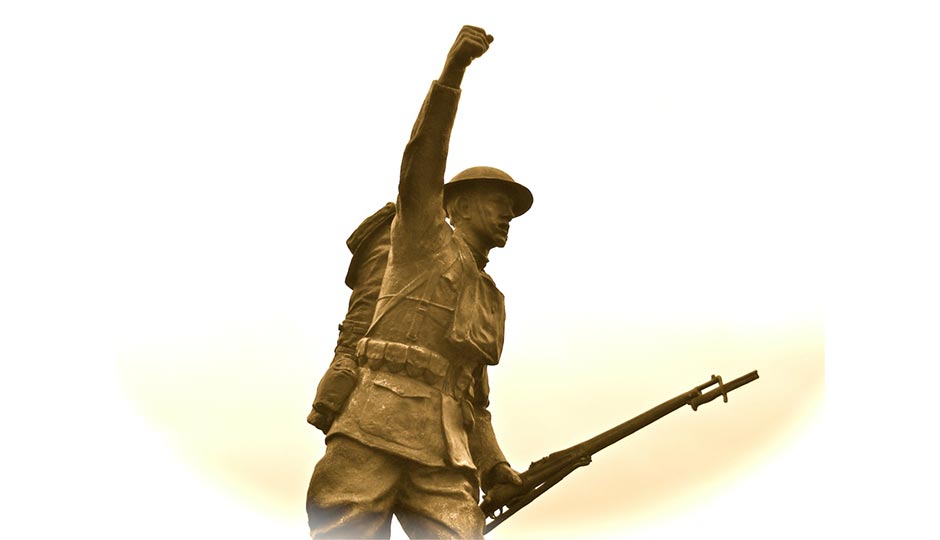
A “doughboy” war memorial / Photograph by James J. Kelly
Northern Liberties neighbors solicited funds door to door after World War I to erect this John Paulding “doughboy” statue at 5th and Buttonwood in 1920. (It’s frequently misidentified as one of Ernest Viquesney’s doughboys.) After the city moved the statue to 17th and Spring Garden in 1975 while widening 5th Street, neighbors rallied again to demand its return to Northern Liberties, and it was reinstalled and rededicated at its current location in 1981. After time and vandalism obliterated the names of local men who’d served in the Great War, a neighbor who saved her father’s copy of the original dedication program was able to provide them. After repairs, the statue was rededicated yet again as part of a pocket park.
American War Mother and Her Sons, Belfield Avenue and 21st Street, Germantown
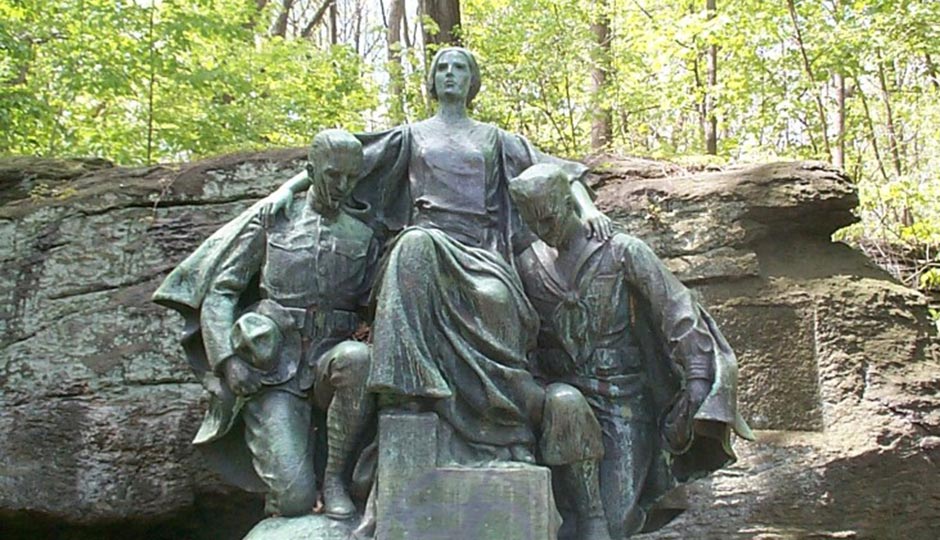
Photograph courtesy of Phila.gov
Mothers have always played a huge role in America’s mythology of war (remember Saving Private Ryan?), and this bronze tableau, installed in 1928, continued the trend. Harry Lewis Raul depicted a seated woman, dressed in plain clothes and a cloak, flanked by a kneeling soldier on her right and a kneeling sailor on her left. Belfield Avenue is named for the ancestral property of William Logan Fisher, who bought it from Charles Willson Peale. Fisher’s daughter, Sarah Logan Fisher, was disinherited by her family for marrying outside their Quaker faith; though her father didn’t attend her wedding to William Wister, he did present her with part of the Belfield land. Sarah and William — he converted to Quakerism eventually and was embraced by her family — had six sons, all of whom, despite their Quaker pacifism, served in the Civil War.
The Washington Monument, Eakins Oval
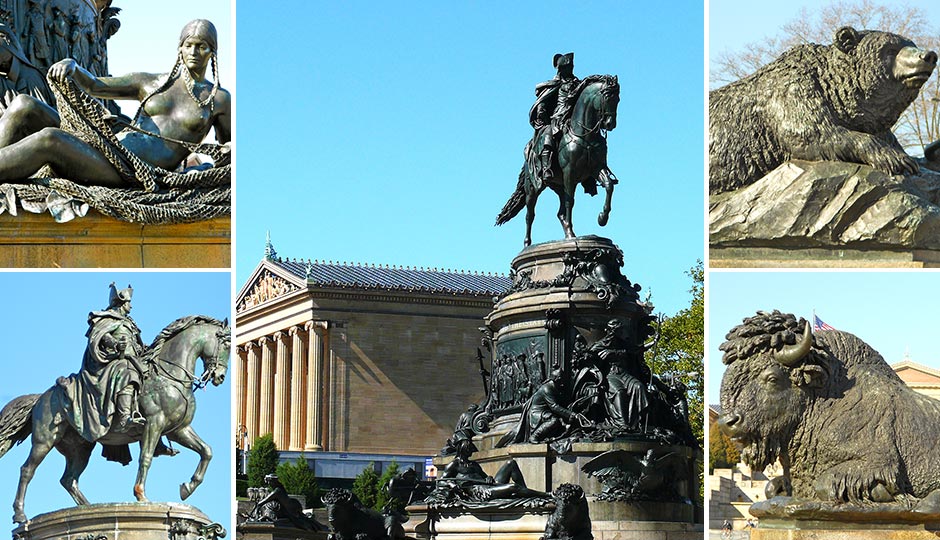
Center photo: “Washington Monument” by Ken Thomas – KenThomas.us. Licensed under Public Domain via Commons. Detail Photos: Smallbones . Licensed under CC0 via Commons.
The vast wedding cake of a sculpture beside the Art Museum steps was designed by German sculptor Rudolf Siemering, most of whose works are overseas. Originally installed at the Green Street entrance to Fairmount Park in 1897, it was moved to its present location in 1928 to serve as the focal point of the newly completed Parkway. Crowned by an equestrian statue of George Washington, it also features buffalo, bears, moose, elk, alligators, a naked woman fishing, naiads, a disheveled woman summoning the nation to war, and a seated Liberty figure crushing the chains of oppression beneath her feet. It’s the story of America in one big, gaudy, solemn extravaganza that’s a lot like America itself.
Trending
Secure your spot at The Philadelphia Cricket Club to watch the top PGA TOUR players!
4 |
: |
6 |
: |
45 |
: |
40 |
||
DAYS |
HRS |
MIN |
SEC |
|||||


